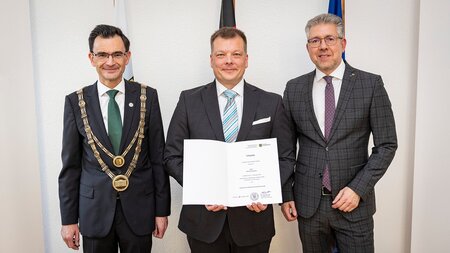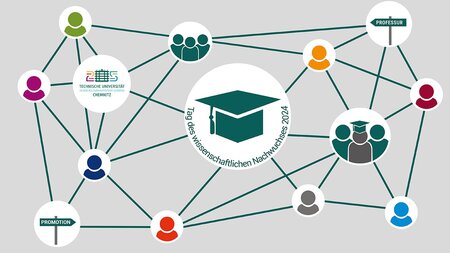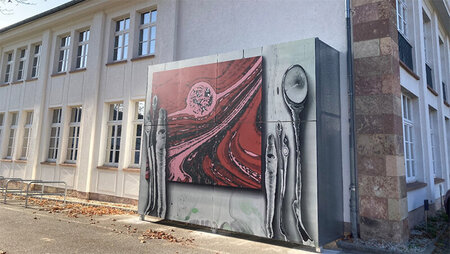How to Experience Virtual Worlds with More Senses
The InnoTeam Presence under the leadership of Chemnitz University of Technology develops technologies and processes to increase the feeling of reality in VR.
-

Scientist Jennifer Brade from the Professorship of Production Systems and Processes tests the feeling of reality during a virtual bicycle tour with a 3D sound system. Photo: Chemnitz University of Technology/René Apitzsch
Imagine, it is a beautiful summer day and you are on a short bike ride across the university campus. You are pedaling hard, steering around a curve, the breeze is brushing your face, the birds are chirping - it could not be more beautiful! But appearances are deceptive, nothing is real: the whole scenario has been elaborately staged. The bicycle stands in the Virtual Reality Center Production Engineering’s five-sided CAVE at Chemnitz University of Technology, where virtual images of the surroundings are projected. The birds’ twitter is played by a newly developed 3D sound projection system from the TU Dresden, and a fan generates the airstream. But why the effort?
Currently, it is still a niche, but in future working environments, virtual reality (VR) technologies will be of great importance, especially in the areas of product development, planning, and training of work processes. Advantages such as time- and location-independent visualization of projects and work speak for themselves. For success in practical use, the sense of presence, i.e. the feeling of really being in this virtual environment and being a part of it, plays an essential role. Previous solutions such as head-mounted displays, VR headsets, or VR CAVEs primarily address the visual level, while other senses are only rudimentarily addressed and are not coordinated. "Ergonomics, the field of vision, and engaging multiple senses have a significant influence on the users’ perception and sense of presence in virtual environments," says scientist Jennifer Brade from the Professorship of Production Systems and Processes (Prof. Dr. Martin Dix), who has been researching how to improve psychological immersion in the virtual world.
Perceiving VR worlds with the senses - Not all senses enhance sensation equally
The InnoTeam Presence initiated by Chemnitz University of Technology has been dedicated to this topic from July 2018 to December 2020. In an alliance with the Chair of Acoustics and Haptics at TU Dresden and four Saxon companies, experts from various disciplines worked together to analyze virtual reality systems and further develop their various components in a coordinated manner. The goal of the project was to design a holistic system that addresses different sensory channels and uses them to improve interaction between humans and the virtual world. A key finding is that not all sensory stimuli actually enhance the feeling of being there. "For example, we surprisingly found that sitting on a real chair, despite a virtual image of that chair, was perceived as very uncomfortable for our subjects and reduced the feeling of presence in the virtual world," describes Jennifer Brade. "The inclusion of 3D sound and wind simulation, on the other hand, greatly increased the sense of presence in the virtual space and even lowered the negative effects of virtual reality such as nausea or headaches."
"Our professorship acted as the lead coordinator of this InnoTeam and was able to draw on many years of experience in researching virtual and augmented reality technologies, gained in a variety of national and international research and industry projects," says Dr-Ing. Philipp Klimant, managing senior engineer of the Professorship of Production Systems and Processes. Specific development goals within the project for the professorship were to improve the areas of visualization, interaction, and data handling and to analyze the possibilities of multilateral linking of the various input and output methods as well as the resulting effects and interactions on the perception of presence. Sikom Software GmbH, manufacturer of systems for voice interaction, as well as plavis GmbH as VR user in the field of factory planning, and interactive minds GmbH, an eye-tracking specialist for AR applications, supported the goals of the project as development partners.
Tangible stimuli from the virtual world
The project, which is part of the People and Technology field of competence, was completed by Chemnitz University of Technology's Professorship of Ergonomics and Innovation Management (Head: Prof. Dr. Angelika Bullinger-Hoffmann). Together with WESOM Textil GmbH, the professorship developed a set of haptic wristbands that transmit tangible vibrations to various parts of the user’s body in the virtual world. Thanks to wireless control, the user can move around the room freely. Context-sensitive feedback can be generated by means of the programmable interface. In addition, the professorship, in cooperation with its partners, developed a user interface as well as an interaction concept for eye movement control by tracking eye movement and investigating new measurement methods for the objective assessment of the sensation of presence.
At the end of the project, all research results were summarized in a method catalog, which contains the effect of the different developments related to the subjectively perceived presence in virtual scenarios. "Thus, despite the COVID-19 limitations in the evaluation phase, the project team has succeeded in drawing important conclusions regarding enhancement in virtual scenarios, which yield indications and guidelines for subsequent developments in the research or industry sector," Jennifer Brade states.
Background: SAB InnoTeam Program
The InnoTeam Presence was funded by the Sächsische Aufbaubank (SAB). The SAB supports cooperation between companies and universities or research institutions in the formation of competence teams that develop a new product or a technological process with the InnoTeam program. The programs’ aim is to strengthen the innovative power and competitiveness of the Saxon economy. This measure is funded by the European Social Fund (ESF) and co-financed by tax revenue based on the budget approved by the members of the Saxon state parliament.
Additional information about the InnoTeam Presence can be received from Jennifer Brade, research assistant at the Professorship of Production Systems and Processes at Chemnitz University of Technology, Tel: 0371 531-33513, E-Mail: jennifer.brade@mb.tu-chemnitz.de.
(Author: Katja Klöden / Translation: Chelsea Burris)
Matthias Fejes
26.02.2021





